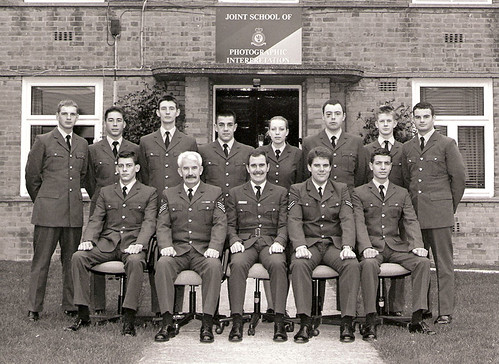Sunday, April 27, 2008
Tuesday, April 22, 2008
Teaching a Plant the Alphabet
By John Baldessari. His "Six Colorful Inside Jobs" was a huge hit at the MoMA "Color Chart" show this weekend, capturing, color by color, an entire floor-ful of the intrigued.
Rave: 30 Rock/Tina Fey
Two weekends ago, it was a beautiful Saturday evening. What did I decide to do? My taxes. What did I actually do? Watch the entirety of Season 2 of 30 Rock on Hulu. [Quick aside: I was skeptical on Hulu as a service, but so far, I'm sold. If advertising is a necessary evil, I don't mind the pre-roll and interspersed 30 second clip model, while watching programs on my computer. Don't let it dissuade you, advertisers, but I check my email and the internet while you tell me about Ragu spaghetti sauce. But don't worry. I already knew about Ragu spaghetti sauce.]
Back to 30 Rock. Best comedy on television since Arrested Development? I think so. Is it Alec Baldwin who really makes the show. Yes, probably (see clip below). Is Tracey Morgan on his game pure joy to watch? Does the show take an enormous amount of pleasure and energy on throw-away bits, often upstaging the character and situation driven humor in the show itself? Delightfully, yes (see clip above).
But, bottom line, if Tina Fey is the spirit animating this show, from its sense of humor to its quirky girl soul, and is continuing in the fine form of her SNL head writer years, then color me even more impressed. The body work she is creating as a writer and, increasingly, as a very charming performer has my full appreciation. Let me go a step further. Will you marry me, Liz Lemon?
Last Flight from Da Nang
Sunday, April 20, 2008
Death of the Label
 It is a Sunday evening, and I just finished reading The Long Tail by Chris Anderson, and am listening to a couple of new CD purchases while leafing through the internet (Destroyer's Trouble In Dreams and Robert Wyatt's Comicopera, if you care). So it seemed like a good time to read David Byrne's article in Wired magazine, "Survival Strategies for Emerging Artists," which served me as an additional point of view on what supposedly momentous shifts are happening in the music industry (and the entertainment industries, more broadly).
It is a Sunday evening, and I just finished reading The Long Tail by Chris Anderson, and am listening to a couple of new CD purchases while leafing through the internet (Destroyer's Trouble In Dreams and Robert Wyatt's Comicopera, if you care). So it seemed like a good time to read David Byrne's article in Wired magazine, "Survival Strategies for Emerging Artists," which served me as an additional point of view on what supposedly momentous shifts are happening in the music industry (and the entertainment industries, more broadly).
The article is worth a read, providing Byrne's perspective as an insider with multiple angles on the music came - as popularly successful act with the Talking Heads, as an independent artist, as a label executive (so to speak) with Luaka Bop. At a high level, the article casts the current music industry as very much in flux, as labels become less important and less necessary as the cost of production of music drastically declines with new recording tools, as the the platforms for marketing and distribution are radically shifting from traditional retail to online and even peer-to-peer, and as the fundamental economics of the business are being called into question. Byrne identifies six potential models of relationships that an artist can have with a label or other business partner, essentially ranging from giving up control and ownership in exchange for resources and a support infrastructure to maintaining control and ownership, but taking on the burden of financing and manufacturing and marketing logistics. I won't summarize the very readable article in much more detail as it is worth a read, and is interspersed with interviews with Thom Yorke from Radiohead and Mac McCaughan from Superchunk and Merge Records.
 A quick aside: having just read The Long Tail, which uses the music industry as an exemplar case for long tail marketing analysis (and, surely, it is, with low production costs, multiple, available distribution channels, a massively differentiated demand profile, and the need and tradition of having multiple levels of filters guiding consumers in refining their individual demand profiles), writing about the music industry and the continued evolution of models for connecting artists to audiences, either cutting out or simply introducing new middle-men always play as an interesting case study for the evolution of other long tail markets, characterized, beyond the long tail demand distribution, by products which are cheap to mass produce and distribute (all non-live entertainment, all software, some physical goods, some services).
A quick aside: having just read The Long Tail, which uses the music industry as an exemplar case for long tail marketing analysis (and, surely, it is, with low production costs, multiple, available distribution channels, a massively differentiated demand profile, and the need and tradition of having multiple levels of filters guiding consumers in refining their individual demand profiles), writing about the music industry and the continued evolution of models for connecting artists to audiences, either cutting out or simply introducing new middle-men always play as an interesting case study for the evolution of other long tail markets, characterized, beyond the long tail demand distribution, by products which are cheap to mass produce and distribute (all non-live entertainment, all software, some physical goods, some services).In terms of the music industry, specifically, I always have a conflicting opinion from watching the evolution in the business from my personal music buying habits. I grew up on CDs, fundamentally digital, so I don't belong to high church of vinyl, but I still like purchasing CDs. I like albums better than singles. I go to shows. I still like going to the record store (granted, I've had the luck of living in New York, the Bay Area, and Rhode Island, where I've had good record stores). As much as I read music magazines (Spin when I was twelve, yes, Pitchfork, now), friends and the taste of record store clerks still guide a lot of my purchasing decisions. And I like to play my music on stereo speakers, out loud, not on my computer or iPod.
So, while the shift to purely digital production and marketing models are exciting, in that they provide new avenues for artists to create and distribute music, and, selfishly, new ways for great music to get to me, there still feels like there is a disconnect to me on how the industry will sufficiently evolve to help connect consumers of music with a greater selection of high quality music. Of course, this gets to the argument for filters from a book like The Long Tail, and while I am glad that record label executives are no longer the pre-release arbiter of good taste, it seems like the current avalanche of music actually may be oddly aligned against the ability of artists to produce music as art, and have that art reach a mass audience.
Right now, the best channels for producing great music are exactly those indie labels like Merge and divisions of bigger labels like Nonesuch, combined with the same music critic press that has always existed, just shifted to a new medium, that are identifying and promoting great music. And one of the potential negative consequences (not to the artists, perhaps, but to the consumer?) of more and varied means for artists to create and distribute music is that it will take more work for consumers to actually identify good music that they will like. Thoughts?
And two slightly related notes:
David Byrne makes passing reference to I Think Music, in his articles, which, at a glance, seems like an aggregator for distributing independent music. Any thoughts on the platform?
And finally, reading an interview with David Berman of the Silver Jews in the Village Voice. Apparently, the new album, coming out in June (which, of course, I am excited for) includes the chords for the songs in the liner notes. According to Berman:
I think in a Pitchfork interview, I did before Tanglewood Numbers came out—I did this long interview, and it was notorious because I explained how much money a person who sells 20,000 records will make. And people—it was shocking to them. It’s the last thing people will talk about, especially if you break it down. I think the latest way that I want to do that, with this album- the chords are all in the album. There are only sixteen chords on the whole album, and so, you always wonder why in the liner notes, bands don’t put their chords there? Its almost like bands are afraid to show how easy it may be. Why is that not often done? Most bands’ chords are only two or three; and people would cover their songs. There is no reason in the world, from a business standpoint—it's insane not to. If you put these things in there, you are encouraging young children to learn to play on them. And those are the people they go on to cover, maybe.Feels gimmicky, but gimmicks aren't so much Berman's thing, as far as I can tell (or would like to believe). And connects oddly to David Byrne's introduction to his piece, tracing music to its communal roots, as a fundamentally live and communally experienced act. Anything to it?
 Addendum. The Thom Yorke interview with David Byrne is also interesting, if for no other reason than how odd (and forward thinking) these two musical geniuses really are. For example:
Addendum. The Thom Yorke interview with David Byrne is also interesting, if for no other reason than how odd (and forward thinking) these two musical geniuses really are. For example:
Byrne: I've been asking myself: Why put together these things — CDs, albums? The answer I came up with is, well, sometimes it's artistically viable. It's not just a random collection of songs. Sometimes the songs have a common thread, even if it's not obvious or even conscious on the artists' part. Maybe it's just because everybody's thinking musically in the same way for those couple of months.
Yorke: Or years.
Byrne: However long it takes. And other times, there's an obvious...
Yorke: ... Purpose.
Byrne: Right. Probably the reason it's a little hard to break away from the album format completely is, if you're getting a band together in the studio, it makes financial sense to do more than one song at a time. And it makes more sense, if you're going to all the effort of performing and doing whatever else, if there's a kind of bundle.
And then this:
Byrne: Do you know, more or less, where your income comes from? For me, it's probably very little from actual music or record sales. I make a little bit on touring and probably the most from licensing stuff. Not for commercials — I license to films and television shows and that sort of thing.
Yorke: Right. We make some doing that.
Byrne: And for some people, the overhead for touring is really low, so they make a lot on that and don't worry about anything else.
Yorke: We always go into a tour saying, "This time, we're not going to spend the money. This time we're going to do it stripped down." And then it's, "Oh, but we do need this keyboard. And these lights." But at the moment we make money principally from touring. Which is hard for me to reconcile because I don't like all the energy consumption, the travel. It's an ecological disaster, traveling, touring.
Byrne: Well, there are the biodiesel buses and all that.
Yorke: Yeah, it depends where you get your biodiesel from. There are ways to minimize it. We did one of those carbon footprint things recently where they assessed the last period of touring we did and tried to work out where the biggest problems were. And it was obviously everybody traveling to the shows.
Byrne: Oh, you mean the audience.
Yorke: Yeah. Especially in the US. Everybody drives. So how the hell are we going to address that? The idea is that we play in municipal places with some transport system alternative to cars. And minimize flying equipment, shipping everything. We can't be shipped, though.
Color Charts from Richter
Food Coma

Lazing in the apartment this afternoon after soccer and a stroll through Brooklyn Flea brought the sorry truth crashing down on my head, as I had the TV on as I puttered about, and the only channel worth watching was 13, since every other over-air channel had been pre-empted by La Papa rock and roll mass-travaganza in Yankee Stadium, and the only thing on 13 was a string of food shows. Two observations: while I enjoy food shows, love watching food made and presented, love the travelogue context in which most of them are presented, I don't think I would personally get along with most food writers. They just seem so pompous, badly built for TV, but also badly built for sharing a dinner table. Second, they need to re-invent smell-o-vision. When you are watching a food show, and the hosts and the guests and everybody involved is just ooh-ing and aah-ing over the aromas in the kitchen, well, how frustrating!
On that note, a few food-related links on the Interweb:
- Chocolate and Zucchini, a Paris-based food blog which I was introduced to while watching one of those shows on 13;
- AR's delightful Treat A Week recipe blog, which was featuring donuts, the last time I checked;
- The Moko's ridiculous and charming candy blog. It's bizarre that she is one of the most influential women in Europe, but she has a secret sugar problem;
- Food Candy, dB's epicurean side-project, which I woefully under-use.
With that, any recommendations for great NYC food resources? Or anywhere I should go eat?
Tuesday, April 15, 2008
Empty Cities: Five From Robert Olsen
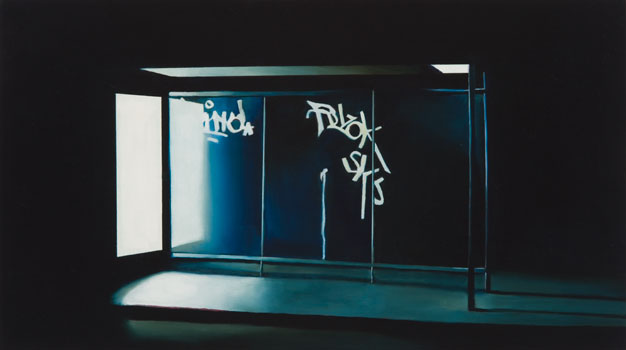

 Went to the Gangbusters show at Plane-Space to see CD and NG's work and, of course, drink free beer, and stumbled upon (yes, courtesy RM, who I totally usurped in purchasing the book, but he didn't need the extra weight heading back to Europe, really, did he?) the paintings of Robert Olsen.
Went to the Gangbusters show at Plane-Space to see CD and NG's work and, of course, drink free beer, and stumbled upon (yes, courtesy RM, who I totally usurped in purchasing the book, but he didn't need the extra weight heading back to Europe, really, did he?) the paintings of Robert Olsen.What can I say about the collection Empty Cities? It's spectral, luminescent, and reminds me of those great, useless artifacts of modern urban convenience that shine on bravely through the night while also representing the loneliness and danger of being gunned down anonymously on an empty street. They shimmer and they shiver from the darkness. They are really great.
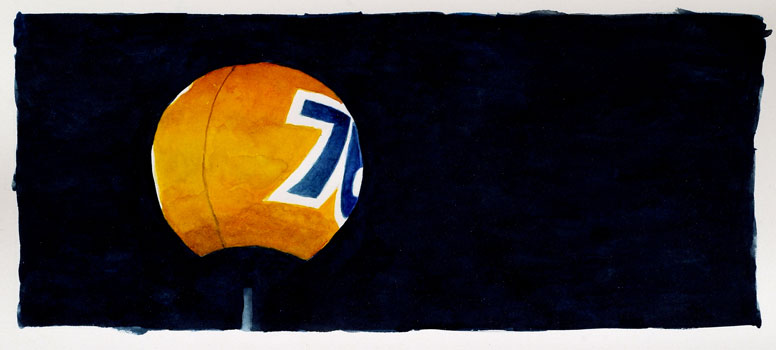
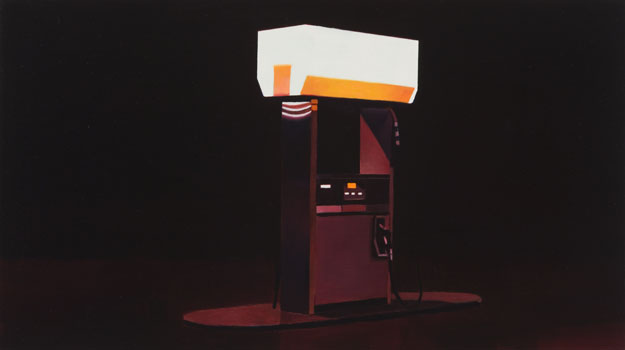
Five from Marcel Dzama



 I was a fan of Marcel Dzama before I knew I was a fan. Wandering around an otherwise largely dull Armory Show in 2004, MM and I happened upon Dzama's weird, whimsical, amusing, and strangely sinister drawings and installations. We both loved them, of course. So even though HH demanded that I go the Dzama show ("Don't you know the cover for Beck's Guero!"), I didn't know who he was, hadn't placed a name with the drawings that so amused me, and didn't go. Not until ED and I were wandering out of the New Museum and ED pointed out the Dzama books to me did I put two and two together. Yes!
I was a fan of Marcel Dzama before I knew I was a fan. Wandering around an otherwise largely dull Armory Show in 2004, MM and I happened upon Dzama's weird, whimsical, amusing, and strangely sinister drawings and installations. We both loved them, of course. So even though HH demanded that I go the Dzama show ("Don't you know the cover for Beck's Guero!"), I didn't know who he was, hadn't placed a name with the drawings that so amused me, and didn't go. Not until ED and I were wandering out of the New Museum and ED pointed out the Dzama books to me did I put two and two together. Yes!Still haven't seen the exhibit at the David Zwirner gallery, and I guess if I don't make it this weekend, I am out of luck.
In the meantime, here's an interview.
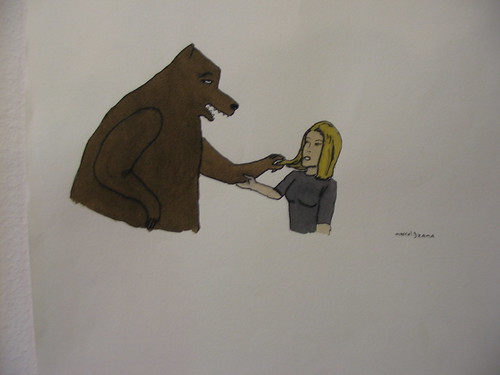
Thursday, April 10, 2008
50 Best Sketches?
In the halcyon days of my latch key youth, The Kids in the Hall on Comedy Central anchored my afternoons. I watched a lot of sketch, and a lot of stand-up, and while I never quite had a spirit guide or mentor as I wound my way through comedy, I think I eventually covered most of the bases. So it was interesting to see the Nerve/IFC-curated 50 Greatest Sketches of All Time list. Does it hold up? Within reason, I suppose, although Laurel & Hardy are shockingly missing (I think they would qualify as sketches...), SNL is grossly over-represented, Mr. Show and The Kids in the Hall, and a hatful of non-Monty Python British-based comedy seems altogether missing. But like any top 50 list, it is hit or miss, and a lot of great stuff is necessarily left out... like the Sam Park Revue. Ha.
Follow the Money: Klosterman Edition
For example, here is an interesting question that fails to get answered, from Esquire:
People hate corporate record labels and love reading about how the industry is failing. As such, the media coverage of plummeting music sales almost always focuses on how labels are losing money. But this coverage usually ignores an economic element that is less tangible but more interesting: What is happening to all the money not being spent on music?Where does the money go? A great, fundamental marketing and economics question, particularly in the face of looming inflation and recession. Anybody have a different, more compelling answer? I'm sure Chuck and I would love to see the data...
In 1999, the total revenue from all music sales (albums and singles) was $14.2 billion. By 2006, it was barely more than $10 billion, including downloads.





